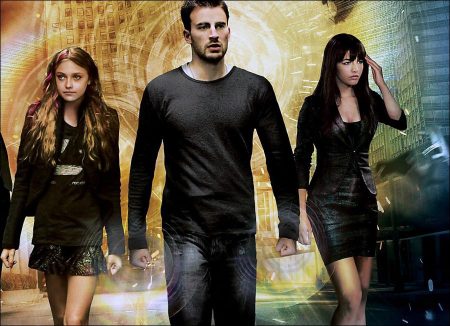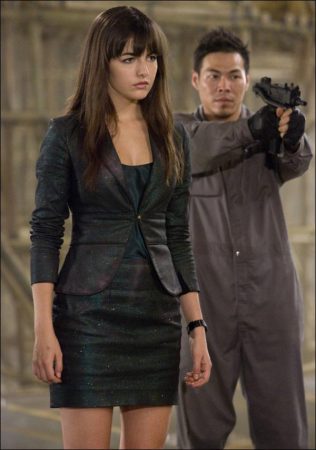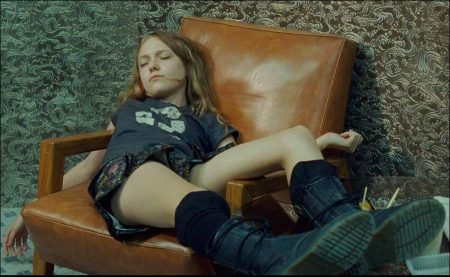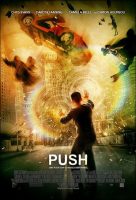All About Push
The premise of Push-a world in which ordinary people capable of astonishing acts are tested and controlled by a secretive government agency-stirred director Paul McGuigan’s curiosity and sent him to the Internet for more information. “I typed in ‘Psychic Powers Experiments,'” says McGuigan. “Out comes this amazing stuff. It’s 1949 and the Cold War is about to begin. People are starting to experiment on what the brain can do.”
McGuigan learned that in the years immediately following World War II, the idea of the use of psychics for information gathering began to take hold in government circles in the U.S. and the Soviet Union. “Think about it,” says Glenn Williamson, producer of Push and president of Back Lot Pictures. “You have someone who can truly see the future or manipulate the thoughts of others. It’s a great counterintelligence asset.
“The movie is very much rooted in those real experiments,” notes Williamson. “The files are still pretty confidential, so I don’t know how much of what really happened we will ever know. The darkest part was during Nazi Germany, but more recently, during the Cold War, both Soviet and American intelligence conducted experiments with people who appeared to have these abilities.”
In Push, a sinister government agency hunts down people with special abilities in an attempt to harness those powers for its own benefit. “The Division is the organization in charge of monitoring people with paranormal abilities,” says Williamson. “But they’ve taken things to the next level and try to control and manipulate them.”
The filmmakers believe the reality behind the movie’s story sets it apart from other films revolving around superheroes. “We wanted to tell a fantastical story in a way that makes it feel very real,” says McGuigan. “I liked the idea of bringing this whole world of people with extraordinary powers to life.
“But the film is not about supernatural powers,” he continues. “It’s about natural powers-things that people could actually do. For example, there are documented cases of people who do what they call ‘remote viewing.’ They would fly people over, say, the American Embassy and these people could get a sense of the building’s layout and they could tell you which room is used for what.”
With that knowledge, it became essential to McGuigan that the characters seemed to be real people in a real world. “I want people to be able to emotionally connect to it. We have all the big effects, but to me, that’s only a little bit of it. It is an action movie, but it’s much more based on the characterizations than action films usually are.”
Williamson adds: “There’s a real story that revolves around Nick and how he turned his back on the world. Cassie is the character that gets him out of it and it becomes a real human relationship. It’s a great ride, but it’s filled with human connection, which I think the best movies have. It’s filled with unexpected situations and real drama.”
One of the decisions McGuigan made that helped keep the focus on the film’s characters was to use CGI effects sparingly. “I didn’t want to do it in green screen or blue screen,” he says. “I wanted to do it for real, through the camera. You can learn a lot from the great filmmakers of the past. They didn’t have the benefit of CGI. They just used their imagination. In the end, the only thing on green screen is people driving, because the traffic in Hong Kong doesn’t move much.”
Chris Evans, who plays Nick Gant, a telekinetic hiding in Hong Kong, found the premise of the script fascinating. “When I first read it, I believed it all,” he says. “Paul and I went back and forth on a daily basis searching for a truth level for the movie. He kept reminding me that there has to be some suspension of belief and that it’s okay just to let the audience go for a ride with us.”
The filmmakers have created a world that closely resembles the one we all live in, but with a few new rules of its own. “There are a lot of great moments in the movie where you’re just not sure what’s going on,” according to Williamson. “Dakota Fanning’s character can see images of the future. Her images are critical to what is happening, but they aren’t crystal-clear and they may be unreliable, like memories.
“That idea helped us show the limits of what people can and can’t do,” the producer says. “One reason we go to movies is that they take us into a world that’s different from our own, whether it’s a complete fantasy or slightly enhanced reality. We want the world of Push to be our world, but with a heightened visual style. So it’s our world, but not our world.”
The film’s young star Dakota Fanning characterizes Push as an action film, but also says, “It’s so much of a personal story. I hope people think it’s really fun. It’s very action-packed and fast-moving, and the visual part of it is amazing.”
Her co-star Evans adds, “We’re not sending any deep messages. This is a pure entertainment film, like a lot of my favorite movies. It has a great script, great action and great characters, so it’s fun all around.”
Push (2009)
Directed by: Paul McGuigan
Starring by: Chris Evans, Dakota Fanning, Camilla Belle, Djimon Hounsou, Maggie Siff, Scott Michael Campbell, Colin Ford, Joel Gretsch, Robert Tsonos, Brandon Rhea
Screenplay by: David Bourla
Production Design by: François Séguin
Cinematography by: Peter Sova
Film Editing by: Nicolas Trembasiewicz
Costume Design by: Laura Goldsmith, Nina Proctor
Set Decoration by: Jeffrey Kong
Music by: Neil Davidge
MPAA Rating: PG-13 for intense sequences of violence and action, brief strong language, smoking and a scene of teen drinking.
Distributed by: Summit Entertainment
Release Date: February 6, 2009
Views: 147






